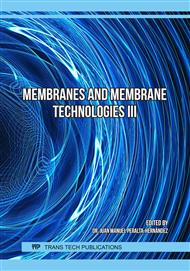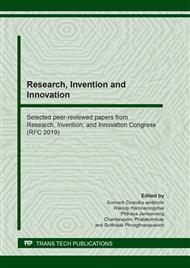[1]
Z.M. Huang, Y.Z. Zhang, M. Kotaki, S. Ramakrishna, A review on polymer nanofibers by electrospinning and their applications in nanocomposites, Compos. Sci. Technol. 63 (2003) 2223–2253.
DOI: 10.1016/s0266-3538(03)00178-7
Google Scholar
[2]
T. Subbiah, G.S. Bhat, R.W. Tock, S. Parameswaran, S.S. Ramkumar, Electrospinning of nanofibers, J. Appl. Polym Sci. 96 (2) (2005) 557–569.
DOI: 10.1002/app.21481
Google Scholar
[3]
D. Sebastián, M.J. Lázaro, I. Suelves, R. Moliner, V. Baglio, A. Stassi, A.S. Aricò, The influence of carbon nanofiber support properties on the oxygen reduction behavior in proton conducting electrolyte-based direct methanol fuel cells, Int. J. Hydrogen energy. 37(2012) 6253-6260.
DOI: 10.1016/j.ijhydene.2011.07.004
Google Scholar
[4]
Y-J. Kim, H-S. Kim, C-H. Doh, S-H. Kim, S-M. Lee, Technological and issues of polyacrylonitrile based nanofiber nonwoven separator for Li-ion rechargeable batteries, J. Power Sources 244 (2013) 196-206.
DOI: 10.1016/j.jpowsour.2013.01.166
Google Scholar
[5]
S. Kaur, S. Sundarrajan, D. Rana, T. Matsuura, S. Ramakrishna, Influence of electrospun fiber size on the separation efficiency of thin film nanofiltration composite membrane, J. Membr. Sci. 392-393 (2012) 101-111.
DOI: 10.1016/j.memsci.2011.12.005
Google Scholar
[6]
D-J. Chen, S. Lei, R-H. Wang, P. Min, Y-Q. Chen, Dielectrophoresis carbon Nanotube and Conductive polyaniline Nanofiber NH3 Gas sensor, Chinese J. Anal. Chem. 40 (2012) 145-149.
DOI: 10.1016/s1872-2040(11)60524-0
Google Scholar
[7]
H. Bang, M. Gopiraman, B-S. Kim, S-H. Kim, I-S Kim, Effects of pH on electrospun PVA/acid-treated MWNT composite nanofibers, Coll. Surf. A: physicochem. Eng Aspects 409 (2012) 112-117.
DOI: 10.1016/j.colsurfa.2012.05.046
Google Scholar
[8]
A.R. Unnithan, N.A.M. Barakat, P.B.T. Pichiah, G. Gnanasekaran, R. Nirmala, Y-S Cha, C-H Jung, M.E. Newehy, H.Y. Kim, Wound-dressing materials with antibacterial activity from electrospun polyurethane-dextran nanofiber mats containing ciprofloxacin HCl, Carbohydrate polym. 90 (2012) 1786-1793.
DOI: 10.1016/j.carbpol.2012.07.071
Google Scholar
[9]
H. Zhang, H. Nie, D. Yu, C. Wu, Y. Zhang, C.J. B. White, L. Zhu, Surface modification of electrospun polyacrylonitrile nanofiber towards developing an affinity membrane for bromelain adsorption, Desalination 256 (2010) 141-147.
DOI: 10.1016/j.desal.2010.01.026
Google Scholar
[10]
Z. Ma, K. Masaya, S. Ramakrishna, Immobilization of Cibacron blue F3GA on electrospun polysulphone ultrafine fiber surfaces towards developing an affinity membrane for albumin adsorption, J. Memb. Sci. 282 (2006) 237–244.
DOI: 10.1016/j.memsci.2006.05.027
Google Scholar
[11]
J. Husheng, H. Wensheng, W. Liqiao, X. Bingshe, L. Xuguang, The structures and antibacterial properties of nano-SiO2 supported silver/zinc–silver materials, Dental mat. 24 (2008) 244-249.
DOI: 10.1016/j.dental.2007.04.015
Google Scholar
[12]
R. Gokulakrishrun, S. Ravikumar, J.A. Raj, In vitro antibacterial potential of metal oxide nanoparticle against antibioticresistant bacterial pathogens. Asian Pacific J. Trop. Dis. (2012) 411-413.
DOI: 10.1016/s2222-1808(12)60089-9
Google Scholar
[13]
N.A. Negm, S.M.I. Morsy, M.M. Said, Biocidal activity of some Mannich base cationic derivatives, Bioorg. & Med. Chem. 13 (2005) 5921–5926.
DOI: 10.1016/j.bmc.2005.07.031
Google Scholar
[14]
H.V. Tran, L.D. Tran, C.T. Ba, H.D. Vu, T.N. Nguyen, D.G. Pham, P.X. Nguyen, Synthesis, characterization, antibacterial and antiproliferative activities of monodisperse chitosan- based silver nanoparticles, Coll. and Surf. A: Physicochem. Eng. Aspects 360 (2010) 32–40.
DOI: 10.1016/j.colsurfa.2010.02.007
Google Scholar
[15]
X. Xu, H. Yan, J. Chen, X. Zhang, Bioactive proteins from mushrooms, Biotech. Adv. 29 (2011) 667–674.
Google Scholar
[16]
J. Zhu, J. Hou, Y. Zhang, M. Tian, T. He, J. Lui, V. Chen, Polymeric antimicrobial membranes enabled by nanomaterials for water treatment. J. Memb. Sci. 550 (2018) 173-197.
DOI: 10.1016/j.memsci.2017.12.071
Google Scholar
[17]
C. Suwanboon, N. Chanunpanich, K. Kittiniyom, Antibacterial membrane from mixed poly (vinylidene fluoride) nanofiber and poly(vinyl alcohol) nanofiber, J. KMUTNB 28 (2018) 881-891. (in Thai).
DOI: 10.14416/j.kmutnb.2018.09.008
Google Scholar
[18]
C.Y. Chen, G.W. Nace, P.L. Irwin, A 6×6 drop plate method for simultaneous colony counting and MPN enumeration of Campylobacter jejuni, Listeria monocytogenes, and Escherichia coli. J. Microbio. Meth. 55 (2) (2003) 475-479.
DOI: 10.1016/s0167-7012(03)00194-5
Google Scholar
[19]
J.Y. Chun, H.K. Kang, L. Jeong, Y.O. Kang, J-E. Oh, I-S. Yeo, SY. Jung, WH. Park, B.M. Min, Epidermal cellular response to poly(vinyl alcohol) nanofibers containing silver nanoparticles, Coll. Surf. B: Biointerfaces 78 (2010) 334-342.
DOI: 10.1016/j.colsurfb.2010.03.026
Google Scholar
[20]
Information on https://www.ncbi. nlm.nih.gov/pmc/articles/PMC4682921.
Google Scholar
[21]
Information on https://www.ncbi.nlm.nih. gov/pmc/articles/PMC4378976.
Google Scholar
[22]
R. B. Wakshlak, R. Pedahzur, D. Avnir, Antibacterial activity of silver-killed bacteria: The Zombies, effect, Science Reports, 5 (2015) April.
DOI: 10.1038/srep09555
Google Scholar
[23]
V. Hemraj, S. Diksha, G. Avneet, A review on commonly used biochemical test for bacteria. Innovare, J. Life Sci. 1 (2013) 1-7.
Google Scholar



